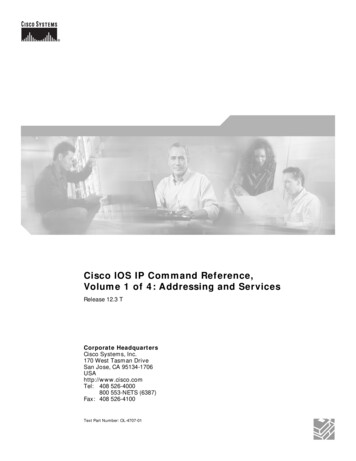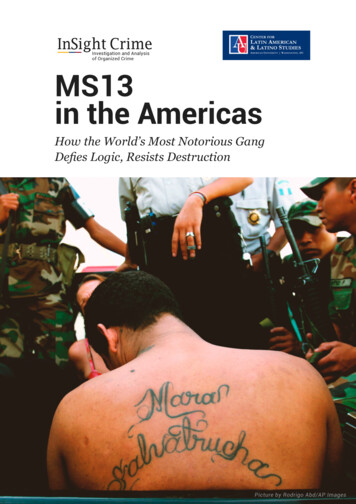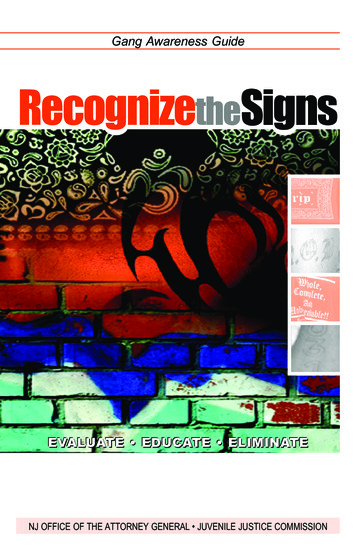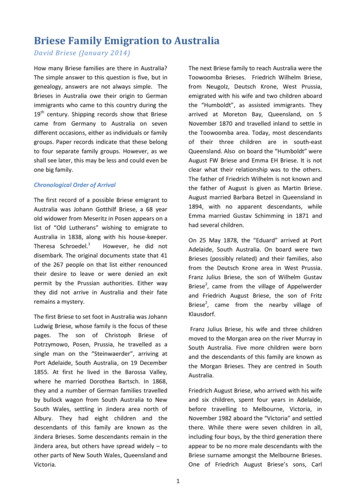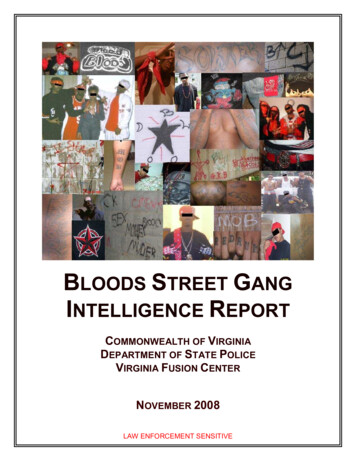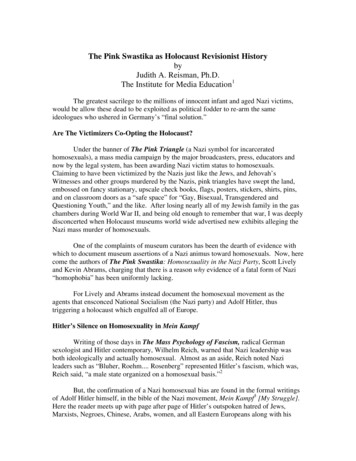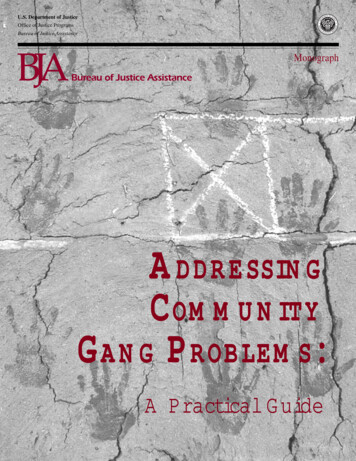
Transcription
Bureau of Justice AssistanceSG OVCRAMSDEPANBJ A C EIOF FOffice of Justice ProgramsNT OF JMEUSRTCETIU.S. Department of JusticeIJJO F OJJ D P B ROJ US T I C E PMonographADDRESSINGCOMMUNITYGANG PROBLEMS:A Practical Guide
U.S. Department of JusticeOffice of Justice Programs810 Seventh Street NW.Washington, DC 20531Janet RenoAttorney GeneralRaymond C. FisherAssociate Attorney GeneralLaurie RobinsonAssistant Attorney GeneralNoël BrennanDeputy Assistant Attorney GeneralNancy E. GistDirector, Bureau of Justice AssistanceOffice of Justice ProgramsWorld Wide Web Home Pagehttp://www.ojp.usdoj.govBureau of Justice AssistanceWorld Wide Web Home Pagehttp://www.ojp.usdoj.gov/BJAFor grant and funding information contactU.S. Department of Justice Response Center1–800–421–6770This document was prepared by the Police Executive Research Forum, supported by cooperative agreement number 91–DD–CX–K058, awarded by the Bureau of Justice Assistance,Office of Justice Programs, U.S. Department of Justice. The opinions, findings, and conclusions or recommendations expressed in this document are those of the authors and do notnecessarily represent the official position or policies of the U.S. Department of Justice.The Bureau of Justice Assistance is a component of the Office of Justice Programs, which alsoincludes the Bureau of Justice Statistics, the National Institute of Justice, the Office of JuvenileJustice and Delinquency Prevention, and the Office for Victims of Crime.
Bureau of Justice AssistanceAddressing CommunityGang Problems:A Practical GuideMay 1998Reprinted August 1999MonographNCJ 164273
Addressing Community Gang Problems: A Practical GuideForewordUrban street-gang involvement in drug trafficking and violent crime is becoming increasingly widespread—not just in large cities, but in suburbanareas and small towns as well.The Bureau of Justice Assistance (BJA) recognizes that programs aimed atcombating gang-related activity must incorporate both crime preventionand crime control initiatives to be effective over long periods of time. Accordingly, in October 1991, BJA initiated the development of a prototypemodel of the Comprehensive Gang Initiative.BJA is pleased to present this monograph, Addressing Community GangProblems: A Practical Guide, as a product of that initiative. It is a useful toolthat provides guidelines for agencies and community groups to developindividualized responses to local gang problems. This practical manualprovides a foundation for understanding the diverse nature of gangs, theproblems they pose and the harm they cause, and the two analytical models for addressing gang-related problems.Two companion monographs complement this one. Addressing CommunityGang Problems: A Model for Problem Solving provides a prototype to assistcommunities in identifying, analyzing, and responding to gang-relatedproblems as well as assessing the effectiveness of their responses. UrbanStreet Gang Enforcement focuses exclusively on enforcement and prosecution strategies to protect against urban street gangs and presents strategiesto enhance the prosecution of gang-related crimes.Nancy E. GistDirectoriii
Addressing Community Gang Problems: A Practical GuideAcknowledgmentsThe Bureau of Justice Assistance (BJA) wishes to thank the Police Executive Research Forum (PERF) and, in particular, John Stedman and DeborahLamm Weisel, for their help and guidance in compiling this document.BJA also thanks the following individuals for their contributions:Deborah Lamm Weisel, Chapter 1.Robert P. McNamara, Chapters 2 and 3.Hugh Nugent, Chapters 4 and 7.William Spelman, Chapter 5.Marilyn B. Ayres, Chapter 6.George E. Capowich, Chapter 8.v
Addressing Community Gang Problems: A Practical GuideContentsExecutive Summary . xiiiI. Understanding Gangs and Gang ProblemsChapter 1Introduction . 3Analytical Models. 4Organization of the Monograph . 6Chapter 2Defining the Community’s Gang(s) . 9Which Definition To Use? . 9Gang Diversity . 11Community Concerns: What To Do? . 14Chapter 3Gang Involvement in Drugs and Violence . 17The Media’s Social Distortion of Gangs . 18Historical Overview of Gangs . 19Types of Gangs . 21Gangs and Drugs . 21Drug Use . 21Drug Selling . 22Drugs and Violence . 22Gangs and Violence. 23The Relationships Among Gangs, Drugs, and Violence . 26Community Responses to the Problem . 27Chapter 4Gang Graffiti . 29What Are Graffiti? . 29Are Graffiti a Problem? . 30Graffiti as Street Art . 31Gang Graffiti . 34Reading Graffiti . 37Alphabets . 37Signs and Symbols . 41Ethnic Graffiti . 43Attacking a Graffiti Problem . 49Controllers . 49Guardians . 50vii
Bureau of Justice AssistanceContents (continued)Manager . 50Offenders . 51Tools . 53Problem Places . 55Responses. 59Establishing a Graffiti Policy . 59Reducing Availability of Graffiti Tools . 59Graffiti Removal Campaigns . 60Target Hardening . 60Discouraging Graffiti. 61Providing Alternatives to Taggers . 61Encouraging Public Responsibility . 62Assessment . 64II. Learning About Local GangsChapter 5Needs Assessments for Gang Problems. 67What Is a Needs Assessment? . 67Aren't Communities Already Doing This? . 69What Is the Needs Assessment Looking For? . 70Step 1: Laying the Groundwork . 72First Steps . 73Scope and Focus . 75Getting the Advisory Board To Buy In . 77Dealing With Conflict. 77Step 2: Identifying Current Activities . 79Defining What Information To Collect . 80Identifying Service Providers . 83Collecting Information . 83Displaying Results . 84Reaping the Benefits of Surveying . 87Step 3: Identifying and Setting Priorities Among Needs . 87Surveying Clients and Their Advocates . 87Tracking and Comparing Social Indicators . 96Step 4: Developing a Consensus . 103Presenting Results to the Advisory Board . 104Going Public . 105Developing Solutions . 106Conclusion . 107viii
Addressing Community Gang Problems: A Practical GuideContents (continued)Chapter 6Addressing Gang Problems ThroughStrategic Planning . 109Using the Definition of Gang To FrameCommunity Responses . 109Factors in Gang Formation and Membership . 110Centrality of a ComprehensiveProblem-Solving Approach . 111Building and Sustaining Coalitions . 112Functions of Coalitions . 113Initiating the Coalition-Building Process . 114Making Coalitions Work . 115Avoiding Pitfalls . 116Strategic Planning . 117Element 1: Mission Formulation . 121Element 2: Organizational Assessment . 123Element 3: Strategic Objectives Development . 125Element 4: Action Plan Development . 129Element 5: Implementation . 134Strategic Plan Evaluation . 138Internal and External Communication Strategies . 139Importance of Diverse Strategiesfor Community Identity . 139Team Building . 140Assistance From an Outside Facilitator . 140Taking Time To Build the Team . 143Initial Team-Building Goals. 144Stages of Team Growth . 145Generating Ideas and Selecting Options . 147Conclusion . 149III. Responding to Local Gang ProblemsChapter 7Civil Remedies for Gang-Related Harm . 153Analytical Models. 153Gang-Problem Triangle . 154Problem-Solving Model . 154Problem Places . 155Residential Sites . 157Commercial Sites . 158Recreational Areas . 158ix
Bureau of Justice AssistanceContents (continued)Public Places . 158Transitional Places . 159Responsible People . 159Civil Remedies . 161Civil or Criminal or Both? . 162Injunction or Damages. 162Nuisance Abatement and Zoning Laws . 163Trespass . 165Waste . 168Civil Code Enforcement and Business Licensing . 168Residential Rental Properties . 171Vacant Buildings and Vacant Lots . 172Overcoming Barriers to Civil Remedies . 172Retaliation Against Individuals . 172Getting Public Officials To Cooperate . 172Delay on Civil Dockets . 173Case Examples of Civil Remedies . 1745081 La Paz Drive, San Diego, California . 174609 East Benton, Joliet, Illinois . 1761615–1617 Russell Street, Berkeley, California . 180Gang-Problem Triangle Applied . 182Conclusion . 183Chapter 8Evaluating Anti-Gang Efforts. 185Process Evaluations . 187Specifying the Program Elements. 189The Purposes of the Evaluation . 189Focusing the Evaluation . 190Collecting Data . 191Impact Evaluations . 192Causal Conclusions . 193Unit of Analysis . 194Levels and Types of Effects. 194Appropriate Measures and Data . 196Data Collection . 197Design and Analysis . 198Overview of Process and Impact Evaluations . 199Appendix A References . 201Appendix B Sources for Further Information . 207x
Addressing Community Gang Problems: A Practical GuideExhibitsExhibitTitlePage1Narrowing the Gap Between Taggers andGangs, Lakewood, Colorado . 352How Taggers Dress, Lakewood, Colorado . 363Differences Between Tagger and Gang Graffiti . 374Hispanic Gang Lettering Styles . 385Barrio Lettering in Old English . 396“Corona” in Old English . 397“SSG” in Sharp-Point Letters . 398“Peace” and “Cats” in Bubble Letters . 409“El Blackbird P 12 St” in Loop Letters . 4110Swastika in Oriental/American Indian Style Letters . 4111Nazi Swastika . 4112Six-Pointed Star . 4213Five-Pointed Star . 4214Hexagram, Pentagram, and Upside-Down Pentagram . 4215Celtic Cross . 4316Formée Cross . 4317Ankh Cross . 4318Guides to Hispanic Gang Graffiti . 4419Black Gang Graffiti . 4520White-Power Graffiti . 4721Removing Graffiti: Markers and Surfaces . 5422Wheel of Misfortune . 7123Austin Project Board of Directors . 7424What a Current Activities Survey Can Reveal . 8125Matrix Showing Survey Results: Funding Sourcesfor Substance Abuse/Addiction Service Providers . 8526Social Indicators Available in Austin,Travis County, and State of Texas . 9827Breakdown of Key Social Indicators Availablein Austin and Travis County, Texas . 10028Map Showing Geographical Breakdown:Births to Teen Mothers in Travis County,Texas, 1989 and 1990 . 101xi
Bureau of Justice AssistanceExhibits (continued)ExhibitxiiTitlePage29Pareto Chart Showing Geographical Data:Neighborhoods at Highest Risk, Child Abuse andNeglect Cases by ZIP Code in Austin, Texas, 1991 . 10230Time-Series Graph Showing Stability Over Time:Births to Teen Mothers in Travis County,Texas, 1980–1990 . 10331Time Chart: Teen Births Among Two AgeGroups in Travis County, Texas, 1980–1990 . 10332Environmental Analysis Worksheet . 12233Mission Statement Worksheet . 12434Organizational Assessment—CriticalIssues Worksheet . 12635Organizational Assessment—Strengths, Weaknesses,Opportunities, and Threats Worksheet . 12736Strategic Objectives Issues Worksheet . 13037Strategic Objectives Successes Worksheet . 13138Strategic Objectives Failures Worksheet . 13239Action Plan Worksheet . 13540Communication Strategy Worksheet . 14141Training Plan Worksheet . 14242Team-Building Worksheet . 14643Gang-Problem Triangle . 15444SARA Model . 15545Types of Harm Caused by Gangs . 15646Gang-Related Problem Places Checklist . 15747Persons Responsible for Problem Places . 16048Sample Logic Diagram . 19049Types of Relationships . 19350Levels and Types of Effects . 19551Relationship Between Processand Impact Evaluation . 200
Addressing Community Gang Problems: A Practical GuideExecutive SummaryChapter 1: IntroductionContemporary gangs—variously known as youth or delinquent gangs andstreet or criminal gangs—have become a widespread threat to communities throughout the Nation. Once considered largely an urban phenomenon, gangs have increasingly emerged in smaller communities,presenting a challenge that severely strains local resources.All gang problems are local in nature. Whether rooted in neighborhoods,representing a rite of passage, or providing surrogate families or access toeconomic opportunity, most gangs are inherently local. Even large-scalegangs with reputed nationwide networks attract local youth and take advantage of local opportunities to carry out gang activities.This monograph presents a problem-solving model that is applied to gangproblems. This model is often referred to as SARA, an acronym for the foursteps involved in the process—scanning, analysis, response, and assessment. Communities first initiate the problem-solving process by searchingfor and identifying gang problems—scanning. The second step of the problem-solving process—analysis—involves investigating the specific gangproblem in greater detail. In general, analysis helps a community understand the nature of its gang problem—how it is manifested, who is harmedand how, and when the problems occur. Having identified their gangproblems and thoroughly analyzed them, communities can proceed to thethird step and develop their local response. The final step of the problemsolving process is an assessment of the effectiveness of the response. It canalso be used to change the response, improve the analysis, or even redefinethe problem.The gang-problem triangle is a method of analyzing or developing adeeper understanding of local gang problems and pointing to fruitful avenues of response. Three elements must be present before a gang-relatedharm can occur: an offender, a victim, and a place. If a person thinks abouteach element as representing a side of a triangle, he or she can easily visualize that removing a side of the triangle will cause the triangle to collapse.An important part of the gang-problem triangle is recognizing that thereare third parties with responsibilities for each side of the triangle. Controllers are people who, acting in the best interest of potential offenders, try toprevent them from committing offenses. Guardians are people who try toprevent harm from coming to potential victims. Managers are people whooversee places where harm occurs. Identifying the people responsible forvictims, offenders, and places and involving them in the development ofplans and programs is necessary if communities are to reduce and preventfuture gang problems.xiii
Bureau of Justice AssistanceChapter 2: Defining theCommunity Youth GangThe term “gang” carries with it many meanings and evokes a number ofimages for people. Discussing some of their different characteristics as wellas different perceptions about them may contribute to a working definitionof gangs. The success or failure of communitywide attempts to addressgang problems is likely to rest, in part, on how the problems are understood and diagnosed.The media, the public, and community agencies use the term “gang” moreloosely than the law enforcement community. Politicians and law enforcement officials tend to rely on legal parameters such as criminal behavior todefine what constitutes a gang. Unfortunately, this perception fails to recognize that many gangs do not engage solely in criminal acts, or evenhighly visible ones. Compounding the definition problem is the inconsistent use of the term “gang related.” Police may classify an incident as gangrelated simply because the individual involved is a gang member.There is no consensus on a standardized definition of a gang, but there issome agreement on the basic elements. Maxson and Klein developed threecriteria for defining a street gang: Community recognition of the group. The group’s recognition of itself as a distinct group of adolescents oryoung adults. The group’s involvement in enough illegal activities to get a consistentnegative response from law enforcement and neighborhood residents.The centerpiece of Richard Cloward and Lloyd Ohlin’s typology of gangsis the concept of differential opportunity. According to this concept, individuals may become involved in gang life and crime simply because legitimate means of success are unavailable to them. Cloward and Ohlin alsosee a differential opportunity structure for illegitimate means of achievingsuccess. The significance of this finding is that all opportunities—legal andillegal—are often unavailable to most inner-city youth.Cloward and Ohlin conclude that young people are likely to join one ofthree types of gangs—criminal, conflict, or retreatist—because of differential opportunity. Criminal gangs are likely to exist in stable low-income areas where there are close relationships between adolescents and adultcriminals. Conflict gangs develop in communities with dilapidated conditions and transient populations. When criminal opportunities do not exist,conflict gangs fight to gain social status and protect their integrity andhonor. Retreatist gangs do not possess the skills to be considered criminalgangs. They retreat into a role on the fringe of society that usually involvesheavy drug use and withdrawal from social interaction.xiv
Addressing Community Gang Problems: A Practical GuideA number of other gangs do not fit neatly into Cloward and Ohlin’s typology. Tagger crews consist of youth banded together to create graffiti. Themain reason for tagging, which is a form of vandalism, is to gain respectfrom fellow artists and, more important, from members of other tagger crews.Communities can begin to develop strategies and programs to addresstheir specific gang problems by analyzing the types of gangs affecting theirneighborhoods. Communities must recognize that the ways in which gangsare defined will, to a large degree, determine the extent of the gang problemin a neighborhood. Moreover, even when one definition is used, such as thelaw enforcement definition, this too varies from one jurisdiction to another.Chapter 3: Gang Involvementin Drugs and ViolenceAmerica has become a society almost preoccupied with gangs—especiallytheir relationship to drugs and violence. While it is true that violenceamong gang members has escalated and involvement in drugs has been afeature of gang life for many years, gangs are now increasingly and almostexclusively blamed for the drug and violence problems of the last decade.This is partly because gangs have grown in number and diversity acrossthe Nation, affecting both large cities and smaller communities.During various times in American history, particularly the 1970s and1980s, gangs have received considerable media attention. Moreover, inmovies, television, radio, newspapers, and even documentaries, the imagecreated about gangs was consistent—they were heavily involved in thedrug trade and exceptionally prone to violence. Based on media accounts,the public believes gangs are extremely violent, are involved in drug trafficking, are highly organized, and are a pervasive part of the social landscape.Gangs and the media both benefit from exaggerated portrayals of gangsand gang life. The media attempt to increase their profits by providing thepublic with sensationalized stories that relate to crime and violence. Increasingly, the media achieve this goal by attributing these events togangs. As the media continue to portray gangs in this negative light, gangmembers gain a reputation of being tough and savvy, enhancing theirstanding in their communities.Another media distortion about gangs relates to their ethnic and racialcomposition. Gangs are not exclusively a minority phenomenon. Most research has attributed gangs and their associated problems to elements inthe social structure—either the social environment or the opportunities associated with being a member of a particular social class. Gangs and violence are associated with urban poverty, and gang life is seen as a sourceof social identity in the face of impoverished living conditions. Moreover,the social and economic opportunities and living conditions of somegroups have not improved—or have become worse. Gang members nowxv
Bureau of Justice Assistancemay be more likely to be motivated by the pursuit of profit than by the cultural or territorial reasons used in earlier decades.One researcher groups gang characteristics into three categories—corporate, territorial, and scavenger. Corporate gangs focus their attention onmaking money. Territorial gangs focus on possession of turf, and gangmembers are quick to use violence to secure or protect what belongs to thegang. Scavenger gangs have very little organizational structure, and gangmembers are motivated by a need to belong to a group.A number of gangs are involved in using and selling drugs, while othersare involved in selling but prohibit use by gang members. Some gangs arehighly organized, while others are fragmented, with individual membersinvolved in drug dealing but acting independently of the gang. And stillother gangs and gang members are heavily involved in using drugs but donot sell them.The research community has found little evidence of a relationship between drug use in general and violent behavior. However, drug users docommit crimes to support their habits, which can lead to violent crimesuch as street robberies. Systemic violence, the type of violence most commonly associated with gangs, is a function of the illegal sale and distribution of drugs. This type of gang violence invades a neighborhood’s senseof community and poses a risk to innocent bystanders.The best possible explanation of the relationship between gangs and violence is that it depends primarily on the gang’s organization. Some gangsare organized to fight, while others are organized to make money, and thelevel of violence associated with each gang depends on its type. In an expressive violent confrontation, the primary goal of violence is injury. Theprimary purpose of instrumental violence is to acquire money or property.Gangs specializing in instrumental violence are strongest in disrupted anddeclining neighborhoods. Gangs involved in expressive violence are strongest in relatively prosperous neighborhoods.Although gang-related violence appears to be increasing, there is little evidence to support the theory that gang involvemen
Gang Problems: A Model for Problem Solving provides a prototype to assist communities in identifying, analyzing, and responding to gang-related problems as well as assessing the effectiveness of their responses. Urban Street Gang En
